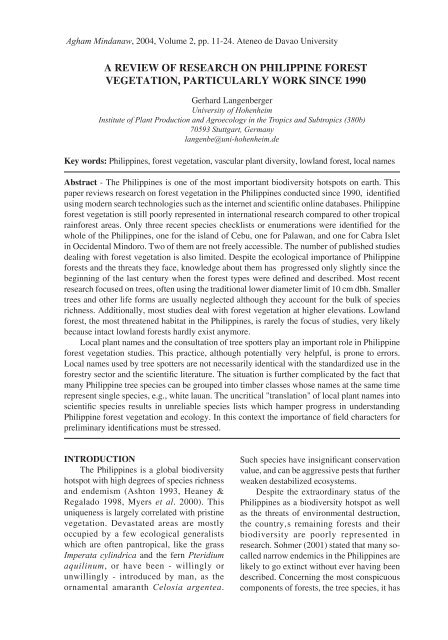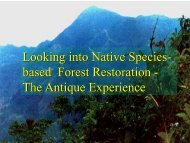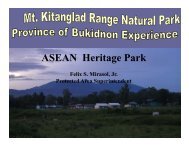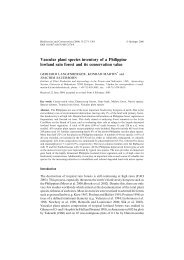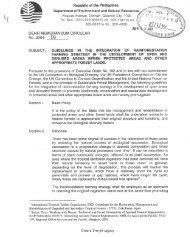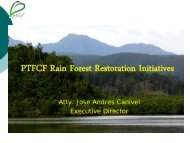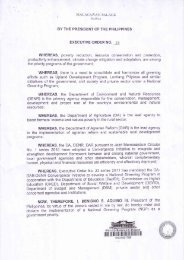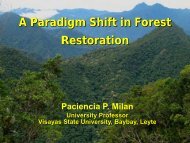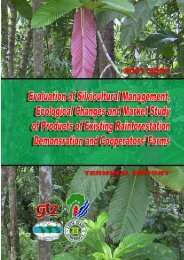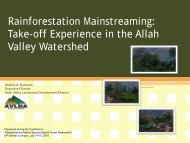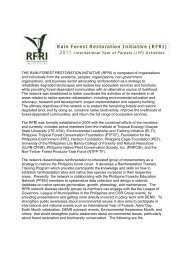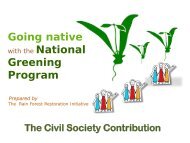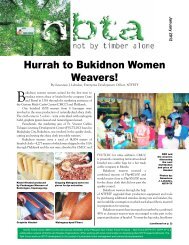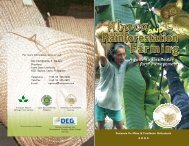a review of research on philippine forest vegetation - Rainforestation
a review of research on philippine forest vegetation - Rainforestation
a review of research on philippine forest vegetation - Rainforestation
You also want an ePaper? Increase the reach of your titles
YUMPU automatically turns print PDFs into web optimized ePapers that Google loves.
Agham Mindanaw, 2004, Volume 2, pp. 11-24. Ateneo de Davao University<br />
A REVIEW OF RESEARCH ON PHILIPPINE FOREST<br />
VEGETATION, PARTICULARLY WORK SINCE 1990<br />
Gerhard Langenberger<br />
University <str<strong>on</strong>g>of</str<strong>on</strong>g> Hohenheim<br />
Institute <str<strong>on</strong>g>of</str<strong>on</strong>g> Plant Producti<strong>on</strong> and Agroecology in the Tropics and Subtropics (380b)<br />
70593 Stuttgart, Germany<br />
langenbe@uni-hohenheim.de<br />
Key words: Philippines, <strong>forest</strong> vegetati<strong>on</strong>, vascular plant diversity, lowland <strong>forest</strong>, local names<br />
Abstract - The Philippines is <strong>on</strong>e <str<strong>on</strong>g>of</str<strong>on</strong>g> the most important biodiversity hotspots <strong>on</strong> earth. This<br />
paper <str<strong>on</strong>g>review</str<strong>on</strong>g>s <str<strong>on</strong>g>research</str<strong>on</strong>g> <strong>on</strong> <strong>forest</strong> vegetati<strong>on</strong> in the Philippines c<strong>on</strong>ducted since 1990, identified<br />
using modern search technologies such as the internet and scientific <strong>on</strong>line databases. Philippine<br />
<strong>forest</strong> vegetati<strong>on</strong> is still poorly represented in internati<strong>on</strong>al <str<strong>on</strong>g>research</str<strong>on</strong>g> compared to other tropical<br />
rain<strong>forest</strong> areas. Only three recent species checklists or enumerati<strong>on</strong>s were identified for the<br />
whole <str<strong>on</strong>g>of</str<strong>on</strong>g> the Philippines, <strong>on</strong>e for the island <str<strong>on</strong>g>of</str<strong>on</strong>g> Cebu, <strong>on</strong>e for Palawan, and <strong>on</strong>e for Cabra Islet<br />
in Occidental Mindoro. Two <str<strong>on</strong>g>of</str<strong>on</strong>g> them are not freely accessible. The number <str<strong>on</strong>g>of</str<strong>on</strong>g> published studies<br />
dealing with <strong>forest</strong> vegetati<strong>on</strong> is also limited. Despite the ecological importance <str<strong>on</strong>g>of</str<strong>on</strong>g> Philippine<br />
<strong>forest</strong>s and the threats they face, knowledge about them has progressed <strong>on</strong>ly slightly since the<br />
beginning <str<strong>on</strong>g>of</str<strong>on</strong>g> the last century when the <strong>forest</strong> types were defined and described. Most recent<br />
<str<strong>on</strong>g>research</str<strong>on</strong>g> focused <strong>on</strong> trees, <str<strong>on</strong>g>of</str<strong>on</strong>g>ten using the traditi<strong>on</strong>al lower diameter limit <str<strong>on</strong>g>of</str<strong>on</strong>g> 10 cm dbh. Smaller<br />
trees and other life forms are usually neglected although they account for the bulk <str<strong>on</strong>g>of</str<strong>on</strong>g> species<br />
richness. Additi<strong>on</strong>ally, most studies deal with <strong>forest</strong> vegetati<strong>on</strong> at higher elevati<strong>on</strong>s. Lowland<br />
<strong>forest</strong>, the most threatened habitat in the Philippines, is rarely the focus <str<strong>on</strong>g>of</str<strong>on</strong>g> studies, very likely<br />
because intact lowland <strong>forest</strong>s hardly exist anymore.<br />
Local plant names and the c<strong>on</strong>sultati<strong>on</strong> <str<strong>on</strong>g>of</str<strong>on</strong>g> tree spotters play an important role in Philippine<br />
<strong>forest</strong> vegetati<strong>on</strong> studies. This practice, although potentially very helpful, is pr<strong>on</strong>e to errors.<br />
Local names used by tree spotters are not necessarily identical with the standardized use in the<br />
<strong>forest</strong>ry sector and the scientific literature. The situati<strong>on</strong> is further complicated by the fact that<br />
many Philippine tree species can be grouped into timber classes whose names at the same time<br />
represent single species, e.g., white lauan. The uncritical "translati<strong>on</strong>" <str<strong>on</strong>g>of</str<strong>on</strong>g> local plant names into<br />
scientific species results in unreliable species lists which hamper progress in understanding<br />
Philippine <strong>forest</strong> vegetati<strong>on</strong> and ecology. In this c<strong>on</strong>text the importance <str<strong>on</strong>g>of</str<strong>on</strong>g> field characters for<br />
preliminary identificati<strong>on</strong>s must be stressed.<br />
INTRODUCTION<br />
The Philippines is a global biodiversity<br />
hotspot with high degrees <str<strong>on</strong>g>of</str<strong>on</strong>g> species richness<br />
and endemism (Asht<strong>on</strong> 1993, Heaney &<br />
Regalado 1998, Myers et al. 2000). This<br />
uniqueness is largely correlated with pristine<br />
vegetati<strong>on</strong>. Devastated areas are mostly<br />
occupied by a few ecological generalists<br />
which are <str<strong>on</strong>g>of</str<strong>on</strong>g>ten pantropical, like the grass<br />
Imperata cylindrica and the fern Pteridium<br />
aquilinum, or have been - willingly or<br />
unwillingly - introduced by man, as the<br />
ornamental amaranth Celosia argentea.<br />
Such species have insignificant c<strong>on</strong>servati<strong>on</strong><br />
value, and can be aggressive pests that further<br />
weaken destabilized ecosystems.<br />
Despite the extraordinary status <str<strong>on</strong>g>of</str<strong>on</strong>g> the<br />
Philippines as a biodiversity hotspot as well<br />
as the threats <str<strong>on</strong>g>of</str<strong>on</strong>g> envir<strong>on</strong>mental destructi<strong>on</strong>,<br />
the country‚s remaining <strong>forest</strong>s and their<br />
biodiversity are poorly represented in<br />
<str<strong>on</strong>g>research</str<strong>on</strong>g>. Sohmer (2001) stated that many socalled<br />
narrow endemics in the Philippines are<br />
likely to go extinct without ever having been<br />
described. C<strong>on</strong>cerning the most c<strong>on</strong>spicuous<br />
comp<strong>on</strong>ents <str<strong>on</strong>g>of</str<strong>on</strong>g> <strong>forest</strong>s, the tree species, it has
12 Gerhard Langenberger<br />
been suggested that the Philippines might be<br />
the least known country in southeast Asia<br />
(Soerianegara & Lemmens 1994).<br />
Additi<strong>on</strong>ally, <strong>forest</strong> vegetati<strong>on</strong> studies<br />
comm<strong>on</strong>ly cover <strong>on</strong>ly trees above a given<br />
minimum diameter, <str<strong>on</strong>g>of</str<strong>on</strong>g>ten being 10 cm at<br />
breast height (dbh). This practice masks the<br />
real plant biodiversity <str<strong>on</strong>g>of</str<strong>on</strong>g> <strong>forest</strong>s since smaller<br />
trees and other life forms like herbs c<strong>on</strong>tribute<br />
much to the overall plant species diversity. On<br />
Mt. Mariveles at the entrance <str<strong>on</strong>g>of</str<strong>on</strong>g> Manila Bay,<br />
Luz<strong>on</strong>, in the Lamao River Reserve, covering<br />
an elevati<strong>on</strong>al range from sea level to c. 1400<br />
m a.s.l., <str<strong>on</strong>g>of</str<strong>on</strong>g> the 1151 species and varieties<br />
identified, 686 were woody plants, <str<strong>on</strong>g>of</str<strong>on</strong>g> which<br />
485 species were classified as trees reaching<br />
a height <str<strong>on</strong>g>of</str<strong>on</strong>g> at least 5 m (Merrill 1906). Thus<br />
58% <str<strong>on</strong>g>of</str<strong>on</strong>g> all plant species and varieties recorded<br />
were either herbaceous (465 species) or woody<br />
shrubs, undershrubs, and scandent shrubs (201<br />
species). With the applicati<strong>on</strong> <str<strong>on</strong>g>of</str<strong>on</strong>g> a 10 cm dbh<br />
limit an additi<strong>on</strong>al porti<strong>on</strong> <str<strong>on</strong>g>of</str<strong>on</strong>g> woody species<br />
which were taller than 5 m but did not reach<br />
the 10 cm diameter threshold would have<br />
been omitted, and the proporti<strong>on</strong> <str<strong>on</strong>g>of</str<strong>on</strong>g> the plant<br />
species richness excluded by this diameter<br />
limit would have been at least two-thirds.<br />
Gentry and Dods<strong>on</strong> (1987) also stressed the<br />
importance <str<strong>on</strong>g>of</str<strong>on</strong>g> the c<strong>on</strong>tributi<strong>on</strong> <str<strong>on</strong>g>of</str<strong>on</strong>g> trees smaller<br />
than 10 cm dbh as well as "n<strong>on</strong>trees" to overall<br />
species richness in tropical rain <strong>forest</strong>s. My<br />
own studies <strong>on</strong> the species compositi<strong>on</strong> in a<br />
lowland <strong>forest</strong> area located at an elevati<strong>on</strong>al<br />
range between 55 and 530 m a.s.l. <strong>on</strong> Leyte,<br />
Philippines, which covered all vascular plants<br />
except crown epiphytes, showed similar<br />
results (Langenberger 2003). Of all plant<br />
species recorded in a total sampling area <str<strong>on</strong>g>of</str<strong>on</strong>g><br />
0.49 ha composed <str<strong>on</strong>g>of</str<strong>on</strong>g> 49 n<strong>on</strong>-c<strong>on</strong>tiguous plots,<br />
<strong>on</strong>ly c. 30% <str<strong>on</strong>g>of</str<strong>on</strong>g> the species were trees growing<br />
taller than 5 m.<br />
A comprehensive overview <str<strong>on</strong>g>of</str<strong>on</strong>g> the literature<br />
dealing with Philippine botany and vegetati<strong>on</strong><br />
up to 1992 has been compiled by Madulid &<br />
Agoo (1992). Since this bibliography is not<br />
readily available outside the Philippines, I<br />
have listed those publicati<strong>on</strong>s dealing with<br />
Philippine vegetati<strong>on</strong> and not menti<strong>on</strong>ed<br />
elsewhere in this paper in Table 1.<br />
The broad foundati<strong>on</strong> <str<strong>on</strong>g>of</str<strong>on</strong>g> Philippine<br />
<strong>forest</strong> vegetati<strong>on</strong> analysis was established in<br />
the beginning <str<strong>on</strong>g>of</str<strong>on</strong>g> the 20th century. The Flora<br />
<str<strong>on</strong>g>of</str<strong>on</strong>g> the Lamao Forest Reserve (Merrill 1906)<br />
and the associated Vegetati<strong>on</strong> <str<strong>on</strong>g>of</str<strong>on</strong>g> the Lamao<br />
Forest Reserve (Whitford 1906), The Flora<br />
<str<strong>on</strong>g>of</str<strong>on</strong>g> Mt. Halc<strong>on</strong> (Merrill 1907), The Flora<br />
<str<strong>on</strong>g>of</str<strong>on</strong>g> Mt. Pulog (Merrill and Merritt 1910),<br />
Philippine dipterocarp <strong>forest</strong>s (Brown &<br />
Mathews 1914), and Vegetati<strong>on</strong> <str<strong>on</strong>g>of</str<strong>on</strong>g> Philippine<br />
Mountains (Brown 1919) are valuable records<br />
<str<strong>on</strong>g>of</str<strong>on</strong>g> what Philippine <strong>forest</strong>s used to be. "The<br />
ascent <str<strong>on</strong>g>of</str<strong>on</strong>g> Mount Halc<strong>on</strong>, Mindoro" (Merrill<br />
1907) describes not <strong>on</strong>ly the <strong>forest</strong> c<strong>on</strong>diti<strong>on</strong>s<br />
encountered during that first documented<br />
ascent <str<strong>on</strong>g>of</str<strong>on</strong>g> Mt. Halc<strong>on</strong>, but also gives a very<br />
vivid impressi<strong>on</strong> <str<strong>on</strong>g>of</str<strong>on</strong>g> the sacrifices made during<br />
expediti<strong>on</strong>s at that time.<br />
The most important <str<strong>on</strong>g>of</str<strong>on</strong>g> the early<br />
publicati<strong>on</strong>s might be The Forests <str<strong>on</strong>g>of</str<strong>on</strong>g> the<br />
Philippines by Whitford (1911). Whitford<br />
defined the Philippine <strong>forest</strong> types and<br />
described their characteristic tree species as<br />
well as the typical envir<strong>on</strong>ment where these<br />
<strong>forest</strong> types and tree species were found.<br />
However, at that time, the tax<strong>on</strong>omic treatment<br />
<str<strong>on</strong>g>of</str<strong>on</strong>g> Philippine plant species - both for trees and<br />
n<strong>on</strong>-trees - was still in its infancy, making<br />
comparis<strong>on</strong>s <str<strong>on</strong>g>of</str<strong>on</strong>g> these early descripti<strong>on</strong>s with<br />
later vegetati<strong>on</strong> studies and their respective<br />
species lists difficult or even impossible.<br />
The ec<strong>on</strong>omically dominant role <str<strong>on</strong>g>of</str<strong>on</strong>g><br />
the dipterocarps appears to have inhibited<br />
detailed vegetati<strong>on</strong> studies, because the great<br />
majority <str<strong>on</strong>g>of</str<strong>on</strong>g> <strong>forest</strong> species have been <str<strong>on</strong>g>of</str<strong>on</strong>g> minor<br />
commercial importance. The tendency to sort<br />
the 65 dipterocarp species (Asht<strong>on</strong> 1993) into<br />
few timber groups, e.g., white and red lauan,<br />
apit<strong>on</strong>g, and yakal (An<strong>on</strong>ymous 1977) hampers<br />
<strong>forest</strong> vegetati<strong>on</strong> analysis up to the present<br />
day. Comparis<strong>on</strong>s with or rec<strong>on</strong>structi<strong>on</strong>s<br />
<str<strong>on</strong>g>of</str<strong>on</strong>g> the former <strong>forest</strong> compositi<strong>on</strong> <str<strong>on</strong>g>of</str<strong>on</strong>g> an area<br />
are tricky, because it can be impossible to<br />
determine which species are really covered<br />
by labels like "white lauan", "red lauan", and<br />
"apit<strong>on</strong>g".<br />
The objective <str<strong>on</strong>g>of</str<strong>on</strong>g> this paper is to present<br />
an overview <str<strong>on</strong>g>of</str<strong>on</strong>g> studies <strong>on</strong> Philippine <strong>forest</strong><br />
vegetati<strong>on</strong> over the last 15 years that are<br />
accessible <strong>on</strong> an internati<strong>on</strong>al level. I will try
Research <strong>on</strong> Philippine <strong>forest</strong> vegetati<strong>on</strong><br />
13<br />
to evaluate the current status <str<strong>on</strong>g>of</str<strong>on</strong>g> vegetati<strong>on</strong><br />
studies, taking into account my own<br />
experience and observati<strong>on</strong>s <strong>on</strong> the island <str<strong>on</strong>g>of</str<strong>on</strong>g><br />
Leyte (Langenberger 2000, 2003).<br />
METHODS<br />
The focus <str<strong>on</strong>g>of</str<strong>on</strong>g> this paper is <strong>on</strong> studies<br />
published after 1990 that deal with the ecology<br />
and plant-biodiversity <str<strong>on</strong>g>of</str<strong>on</strong>g> Philippine <strong>forest</strong><br />
vegetati<strong>on</strong>. These publicati<strong>on</strong>s were identified<br />
using several procedures. The literature<br />
already identified for my own study from<br />
1996 to 1998 (Langenberger 2003) served<br />
as basis. Additi<strong>on</strong>ally, I searched scientific<br />
articles indexed or abstracted in the data<br />
bases CAB Abstracts and Current C<strong>on</strong>tents<br />
from 1984 to October 2003, and I c<strong>on</strong>ducted an<br />
internet search with the search engine Google.<br />
As search parameters for both electr<strong>on</strong>ic<br />
searches I applied the following terms as<br />
well as combinati<strong>on</strong>s <str<strong>on</strong>g>of</str<strong>on</strong>g> the terms: Philippines,<br />
diversity, tropical rain <strong>forest</strong>, vascular plant<br />
species, vegetati<strong>on</strong>, undergrowth. The articles<br />
and references brought up by the search were<br />
evaluated c<strong>on</strong>cerning their relevance for this<br />
paper. Papers discussing the importance <str<strong>on</strong>g>of</str<strong>on</strong>g><br />
<strong>forest</strong> vegetati<strong>on</strong> for biodiversity c<strong>on</strong>servati<strong>on</strong>,<br />
soil preservati<strong>on</strong>, and watershed management<br />
that did not add any new facts about those<br />
<strong>forest</strong>s were not included in this treatment.<br />
RESULTS<br />
Publicati<strong>on</strong>s since 1990 addressing<br />
Philippine <strong>forest</strong> vegetati<strong>on</strong> can be classified<br />
into three categories:<br />
Articles with a tax<strong>on</strong>omic background.<br />
The revisi<strong>on</strong> <str<strong>on</strong>g>of</str<strong>on</strong>g> Philippine Medinilla by<br />
Regalado (1995) and all revisi<strong>on</strong>s for Flora<br />
Malesiana (van Steenis 1950-<strong>on</strong>going) bel<strong>on</strong>g<br />
to this category. Publicati<strong>on</strong>s <strong>on</strong> new species<br />
or new records also bel<strong>on</strong>g to this category,<br />
typical examples being the descripti<strong>on</strong> <str<strong>on</strong>g>of</str<strong>on</strong>g> new<br />
moss records from Mindanao (Tan et al. 2000)<br />
or Mindoro (Tan & Mandia 2001). Although<br />
such publicati<strong>on</strong>s c<strong>on</strong>tain valuable informati<strong>on</strong><br />
<strong>on</strong> the ecology <str<strong>on</strong>g>of</str<strong>on</strong>g> the respective species (e.g.,<br />
life form, distributi<strong>on</strong>, habitat), their main<br />
focus is <str<strong>on</strong>g>of</str<strong>on</strong>g> a documentary and classificatory<br />
kind, and not that <str<strong>on</strong>g>of</str<strong>on</strong>g> an ecological approach.<br />
A sec<strong>on</strong>d category <str<strong>on</strong>g>of</str<strong>on</strong>g> article reports the<br />
plant species found in a given area or island,<br />
like the checklist <str<strong>on</strong>g>of</str<strong>on</strong>g> flowering plants <str<strong>on</strong>g>of</str<strong>on</strong>g><br />
Cebu Island by Bicknell & Bicknell (2001).<br />
Its informati<strong>on</strong> is <str<strong>on</strong>g>of</str<strong>on</strong>g> special importance for<br />
the evaluati<strong>on</strong> <str<strong>on</strong>g>of</str<strong>on</strong>g> the ecological status and<br />
c<strong>on</strong>servati<strong>on</strong> value <str<strong>on</strong>g>of</str<strong>on</strong>g> the studied locality.<br />
Such a checklist enables c<strong>on</strong>clusi<strong>on</strong>s <strong>on</strong> the<br />
vegetati<strong>on</strong> types occurring in the area, if the<br />
ecology and habitat preferences <str<strong>on</strong>g>of</str<strong>on</strong>g> species are<br />
well known. However, this is <str<strong>on</strong>g>of</str<strong>on</strong>g>ten not the<br />
case, and <strong>on</strong>ly few species or species groups<br />
are so characteristic for a given habitat as<br />
mangroves.<br />
The third category <str<strong>on</strong>g>of</str<strong>on</strong>g> publicati<strong>on</strong> deals<br />
with the interacti<strong>on</strong>s between plants and their<br />
envir<strong>on</strong>ment, be it other plants, animals, or<br />
the abiotic envir<strong>on</strong>ment comprising soils,<br />
precipitati<strong>on</strong>, and elevati<strong>on</strong> and temperature.<br />
These can be classified as ecological studies<br />
aiming at a better understanding <str<strong>on</strong>g>of</str<strong>on</strong>g> complex<br />
envir<strong>on</strong>mental correlati<strong>on</strong>s. Examples are<br />
Proctor et al. (1998), Buot and Okitsu (1999),<br />
or Ingle (2003).<br />
With the exclusi<strong>on</strong> <str<strong>on</strong>g>of</str<strong>on</strong>g> tax<strong>on</strong>omic<br />
treatments, the first category, all accessible<br />
studies and references encountered during<br />
my searches <strong>on</strong> articles <strong>on</strong> Philippine <strong>forest</strong><br />
vegetati<strong>on</strong> are listed in Table 2. Tax<strong>on</strong>omic<br />
treatments were omitted because they are<br />
focused <strong>on</strong> plant groups and their classificati<strong>on</strong><br />
and not <strong>on</strong> the species compositi<strong>on</strong> <str<strong>on</strong>g>of</str<strong>on</strong>g> a given<br />
vegetati<strong>on</strong> type or locality. Theses and<br />
reports that are <strong>on</strong>ly locally accessible were<br />
not included.<br />
SPECIES LISTS<br />
Bicknell & Bicknell (2001) compiled a<br />
species check list for the whole <str<strong>on</strong>g>of</str<strong>on</strong>g> Cebu island<br />
and listed 1467 species <str<strong>on</strong>g>of</str<strong>on</strong>g> spermatophytes.<br />
They did not include plants which were found<br />
exclusively in cultivati<strong>on</strong> - a discriminati<strong>on</strong> and<br />
clarificati<strong>on</strong> desirable also for other studies. As<br />
a checklist for the whole island, it encompasses<br />
Cebu´s envir<strong>on</strong>mental heterogeneity in terms<br />
<str<strong>on</strong>g>of</str<strong>on</strong>g> soils, elevati<strong>on</strong>, and degree <str<strong>on</strong>g>of</str<strong>on</strong>g> disturbance.<br />
In c<strong>on</strong>trast to many other species lists based<br />
<strong>on</strong> herbarium specimens which might have<br />
been collected 100 years ago, the list by
14 Gerhard Langenberger<br />
Table 1. Publicati<strong>on</strong>s <strong>on</strong> Philippine vegetati<strong>on</strong> (excluding mangrove <strong>forest</strong>s) before 1990, based <strong>on</strong> the compilati<strong>on</strong> by Madulid and Agoo (1992), with some additi<strong>on</strong>s.<br />
Title 1 Remarks<br />
Abrams, N. (1961): A short list <str<strong>on</strong>g>of</str<strong>on</strong>g> Mansaka flora and their uses. Philipp. J. Sci. 90(1):<br />
25-36.<br />
This article lists plants used by the Mansaka in the Davao regi<strong>on</strong>. It would nowadays<br />
be classified as ethnobotany. The species list is informative, comparing the Mansaka<br />
name, the comm<strong>on</strong> name, and the scientific name, as well as giving the use <str<strong>on</strong>g>of</str<strong>on</strong>g> the<br />
plants. It covers from mangrove to mountain habitats.<br />
Allen, M.S. (1985): The rain<strong>forest</strong>s <str<strong>on</strong>g>of</str<strong>on</strong>g> Northeastern Luz<strong>on</strong> and Agta foragers. In: The<br />
Agta <str<strong>on</strong>g>of</str<strong>on</strong>g> NE Luz<strong>on</strong>: Recent Studies. University <str<strong>on</strong>g>of</str<strong>on</strong>g> San Carlos, Cebu City, pp. 45-68.<br />
Bernard, M.A. (1959): The ascent <str<strong>on</strong>g>of</str<strong>on</strong>g> Mt. Apo, 1859-1958. Philipp. Studies 7(1): 7-67.<br />
Brown, W.H. and Argüelles, A.S. (1917): The compositi<strong>on</strong> and moisture c<strong>on</strong>tent<br />
<str<strong>on</strong>g>of</str<strong>on</strong>g> the soils in the types <str<strong>on</strong>g>of</str<strong>on</strong>g> vegetati<strong>on</strong> at different elevati<strong>on</strong>s <strong>on</strong> Mount Maquiling.<br />
Philipp. J. Sci. A, 12(5): 221-234.<br />
An interesting article about moisture c<strong>on</strong>tent <str<strong>on</strong>g>of</str<strong>on</strong>g> soils and its impact <strong>on</strong> vegetati<strong>on</strong>.<br />
Despite much progress in knowledge <strong>on</strong> this matter the article is still worthwhile<br />
reading.<br />
Brown, W.H., Merrill, E.D. and Yates, H.S. (1917): The revegetati<strong>on</strong> <str<strong>on</strong>g>of</str<strong>on</strong>g> Volcano<br />
Island, Luz<strong>on</strong>, PI, since the erupti<strong>on</strong> <str<strong>on</strong>g>of</str<strong>on</strong>g> Taal Volcano in 1911. Philipp. J. Sci. C.<br />
Botany 12(4): 177-248.<br />
A comprehensive account <strong>on</strong> the status <str<strong>on</strong>g>of</str<strong>on</strong>g> the plant successi<strong>on</strong> after the erupti<strong>on</strong> <str<strong>on</strong>g>of</str<strong>on</strong>g><br />
1911 as well as background informati<strong>on</strong> <strong>on</strong> the volcano’s history.<br />
Colina, A. and Jumalom, J. (1973): Report <strong>on</strong> the flora <str<strong>on</strong>g>of</str<strong>on</strong>g> Basey Regi<strong>on</strong>, Southwestern<br />
Samar, Philippines. Leyte-Samar Studies 7(1): 38-68.<br />
Colina, A. and Jumalom, J. (1974): The geographical distributi<strong>on</strong> <str<strong>on</strong>g>of</str<strong>on</strong>g> the flora <str<strong>on</strong>g>of</str<strong>on</strong>g><br />
Catipla, Cebu and Basey, Samar. Philipp. Scientist 9: 33-41.<br />
Gates, F.C. (1914): Swamp vegetati<strong>on</strong> in hot springs areas at Los Baños, Laguna, P.I.<br />
Philipp. J. Sci. C. 9(6): 495-516.<br />
The <strong>on</strong>ly article encountered dealing with swamp vegetati<strong>on</strong>. Swamp vegetati<strong>on</strong> at<br />
Los Baños has been seriously modified since 1914. The article with its enumerati<strong>on</strong> <str<strong>on</strong>g>of</str<strong>on</strong>g><br />
species is therefore an important document.<br />
Gates, F.C. (1914): The pi<strong>on</strong>eer vegetati<strong>on</strong> <str<strong>on</strong>g>of</str<strong>on</strong>g> Taal Volcano. Philipp. J. Sci. C. Botany<br />
9(5): 391-434.<br />
Gives an account <strong>on</strong> the vegetati<strong>on</strong> <str<strong>on</strong>g>of</str<strong>on</strong>g> Taal volcano shortly after the 1911 erupti<strong>on</strong>.<br />
As stated by Brown et al. (1917), the observati<strong>on</strong>s seem sometimes to be a bit<br />
superficial.
Research <strong>on</strong> Philippine <strong>forest</strong> vegetati<strong>on</strong><br />
15<br />
Herbert, D.A. (1924): Plant life <strong>on</strong> Mt. Makiling. Philipp. Agric. 13(5): 183-197.<br />
Jacobs, M. (1972): The plant world <str<strong>on</strong>g>of</str<strong>on</strong>g> Luz<strong>on</strong>´s highest mountains. Rijksherbarium,<br />
Leiden. 32 pp.<br />
Kellman, M.C. (1970): Sec<strong>on</strong>dary plant successi<strong>on</strong> in tropical m<strong>on</strong>tane Mindanao.<br />
Research School <str<strong>on</strong>g>of</str<strong>on</strong>g> Pacific Studies. Publicati<strong>on</strong> BG/2. Australian Nati<strong>on</strong>al<br />
University. ISBN 0708103510.<br />
Mendoza, D.R. and Jacobs, M. (1968): A preliminary report <str<strong>on</strong>g>of</str<strong>on</strong>g> the botanical<br />
explorati<strong>on</strong> <str<strong>on</strong>g>of</str<strong>on</strong>g> Mt. Pulog and Tabayoc, Kabayan, Benguet and the Sierra Madre Mt.<br />
Ranges at Dingalan and Baler, Quez<strong>on</strong>. Proc. <str<strong>on</strong>g>of</str<strong>on</strong>g> the 1968 Nat. Sci. and Tech. Week,<br />
Part 3: 411-439.<br />
Merritt, M.L. (1908): The Forests <str<strong>on</strong>g>of</str<strong>on</strong>g> Mindoro. Bur. For. Bull. No. 8. Manila, 51 pp.<br />
Pancho, J.V. (1967): Flora <str<strong>on</strong>g>of</str<strong>on</strong>g> Volcano Island. Philipp. Agric. 50(7): 587-625.<br />
Panot, I.A. (1983): Floristic compositi<strong>on</strong> <str<strong>on</strong>g>of</str<strong>on</strong>g> Mt. Pulog. Canopy 6:<br />
Payawal, P.C. and Markgraf, V. (1981): Vegetati<strong>on</strong> and modern pollen rain <str<strong>on</strong>g>of</str<strong>on</strong>g> Mt.<br />
Makiling, Philippines. I. Vegetati<strong>on</strong> analysis <str<strong>on</strong>g>of</str<strong>on</strong>g> the NE slope. Kalikasan, Philipp. J.<br />
Biol. 10(2-3): 255-267.<br />
Seidenschwarz, F. (1988): Forest types <str<strong>on</strong>g>of</str<strong>on</strong>g> Cebu Island. Philipp. Quart. Cult. and<br />
Soc. 16(2): 93-105.<br />
Sutherland, R.K. (1944): Vegetati<strong>on</strong> Study <str<strong>on</strong>g>of</str<strong>on</strong>g> the Philippines. AGS, SW Pacific<br />
Area, Philippines. 114 pp.<br />
Weidelt, H.J. and Banaag, V.S. (1982): Aspects <str<strong>on</strong>g>of</str<strong>on</strong>g> Management and Silviculture <str<strong>on</strong>g>of</str<strong>on</strong>g><br />
Philippine Dipterocarp Forests. TZ Verlagsgesellschaft mbH, Bruchwiesenweg 19,<br />
D-6101 Rossdorf 1. (GTZ Publicati<strong>on</strong> Nr. 132). 302 pp. ISBN 3-88085-157-3.<br />
Whitford, H.N. (1909): Studies in the vegetati<strong>on</strong> <str<strong>on</strong>g>of</str<strong>on</strong>g> the Philippines. I The<br />
compositi<strong>on</strong> and volume <str<strong>on</strong>g>of</str<strong>on</strong>g> the dipterocarp <strong>forest</strong>s <str<strong>on</strong>g>of</str<strong>on</strong>g> the Philippines. Phil. Jour.<br />
Sci. C, 4(6): 699-747.<br />
Comprehensive study <strong>on</strong> plant successi<strong>on</strong> and determining factors <strong>on</strong> Mindanao<br />
including species lists.<br />
Classifies <strong>forest</strong>s <strong>on</strong> Mt. Makiling using cluster analysis. Names some comm<strong>on</strong><br />
species but does not give complete species list used for the analysis.<br />
Although dealing with the management <str<strong>on</strong>g>of</str<strong>on</strong>g> dipterocarp <strong>forest</strong>s, this book c<strong>on</strong>tains much<br />
informati<strong>on</strong> about species compositi<strong>on</strong> <str<strong>on</strong>g>of</str<strong>on</strong>g> <strong>forest</strong> types and habitat preferences <str<strong>on</strong>g>of</str<strong>on</strong>g> tree<br />
species, especially <strong>on</strong> Mindanao. It also c<strong>on</strong>tains a chapter <strong>on</strong> mountain <strong>forest</strong>s.<br />
Deals mainly with ec<strong>on</strong>omic aspects <str<strong>on</strong>g>of</str<strong>on</strong>g> dipterocarp <strong>forest</strong>s in different regi<strong>on</strong>s<br />
<str<strong>on</strong>g>of</str<strong>on</strong>g> the Philippines.
16 Gerhard Langenberger<br />
Bicknell & Bicknell (2001) is the result <str<strong>on</strong>g>of</str<strong>on</strong>g><br />
intensive field work during recent years and<br />
represents the current status <str<strong>on</strong>g>of</str<strong>on</strong>g> the island´s<br />
species compositi<strong>on</strong>. A comparable work is<br />
the "Preliminary checklist <str<strong>on</strong>g>of</str<strong>on</strong>g> the flowering<br />
plants <str<strong>on</strong>g>of</str<strong>on</strong>g> Palawan, Philippines" by Soejarto<br />
et al. (1995). While the check list by Bicknell<br />
& Bicknell (2001) was - at least for a short time<br />
- accessible as a web page that by Soejarto et<br />
al. (1995) is not publicly available (see entry<br />
in the Literature Cited secti<strong>on</strong>). A third species<br />
list has been published by Buot et al. (1990).<br />
They studied the flowering plants <str<strong>on</strong>g>of</str<strong>on</strong>g> the small<br />
Cabra Islet (965 ha) which is part <str<strong>on</strong>g>of</str<strong>on</strong>g> Lubang<br />
Island, Occidental Mindoro. They identified<br />
68 families, 245 genera, and 308 species <str<strong>on</strong>g>of</str<strong>on</strong>g><br />
flowering plants. As the authors state and as<br />
can be seen from the species list itself, Cabra<br />
Islet is a disturbed site dominated by weeds.<br />
For completeness, the few‚ historical‚<br />
species enumerati<strong>on</strong>s are also menti<strong>on</strong>ed<br />
here. A comprehensive treatment <str<strong>on</strong>g>of</str<strong>on</strong>g> the flora<br />
found around Manila was given by Merrill<br />
(1912) in his Flora <str<strong>on</strong>g>of</str<strong>on</strong>g> Manila. It includes<br />
plant descripti<strong>on</strong>s and identificati<strong>on</strong> keys, but<br />
suffers from its outdated tax<strong>on</strong>omy and age,<br />
which makes its present-day applicability<br />
questi<strong>on</strong>able, taking into c<strong>on</strong>siderati<strong>on</strong> the<br />
tremendous envir<strong>on</strong>mental changes which<br />
have taken place in the Manila area since<br />
the beginning <str<strong>on</strong>g>of</str<strong>on</strong>g> the 20th century. Another<br />
approach for a single mountain, the Vascular<br />
Flora <str<strong>on</strong>g>of</str<strong>on</strong>g> Mount Makiling and Vicinity by<br />
Pancho (1983), which includes very good<br />
drawings, has never been completed and is<br />
represented by <strong>on</strong>ly <strong>on</strong>e volume. The most<br />
comprehensive species list is the Enumerati<strong>on</strong><br />
<str<strong>on</strong>g>of</str<strong>on</strong>g> Philippine Flowering Plants by Merrill<br />
(1923-26), which is the <strong>on</strong>ly publicati<strong>on</strong><br />
dealing with the whole Philippines, but<br />
which is also in urgent need <str<strong>on</strong>g>of</str<strong>on</strong>g> a revised and<br />
tax<strong>on</strong>omically updated editi<strong>on</strong>.<br />
ECOLOGICAL STUDIES<br />
OF VEGETATION<br />
The sec<strong>on</strong>d group <str<strong>on</strong>g>of</str<strong>on</strong>g> data set treated here<br />
covers vegetati<strong>on</strong> studies dealing with plants<br />
and their interacti<strong>on</strong>s with the envir<strong>on</strong>ment.<br />
Five data sets deal with vascular plants and are<br />
not restricted to trees or woody plants al<strong>on</strong>e.<br />
Gruezo and Badayos (1996) c<strong>on</strong>ducted an<br />
Envir<strong>on</strong>mental Impact Assessment for the<br />
Philippine Nati<strong>on</strong>al Oil Corporati<strong>on</strong> around<br />
Mt. Labo, Camarines Norte Province, Luz<strong>on</strong>.<br />
They established six circular plots <str<strong>on</strong>g>of</str<strong>on</strong>g> 40 m<br />
diameter and seven rectangular plots <str<strong>on</strong>g>of</str<strong>on</strong>g> 50<br />
m 2 within an elevati<strong>on</strong>al range from 410 to<br />
1500 m a.s.l. The area was affected by large<br />
scale logging operati<strong>on</strong>s 30 years ago. A total<br />
<str<strong>on</strong>g>of</str<strong>on</strong>g> 385 species, 255 genera, and 112 families<br />
were identified, but the number <str<strong>on</strong>g>of</str<strong>on</strong>g> species<br />
found cannot be referred to the overall plot<br />
size inventoried (ca. 0.789 ha) because plants<br />
observed in the vicinity <str<strong>on</strong>g>of</str<strong>on</strong>g> the plots were also<br />
included.<br />
Gruezo (1998) established transect lines<br />
<strong>on</strong> Pagbilao in Quez<strong>on</strong>, Luz<strong>on</strong>, and Pagbilao<br />
Grande Island covering a total area <str<strong>on</strong>g>of</str<strong>on</strong>g> 0.26<br />
ha. The elevati<strong>on</strong>al range is not given, but<br />
the locality is a typical lowland envir<strong>on</strong>ment.<br />
Gruezo (1998) encountered 301 vascular plant<br />
species. As can be seen from the species lists<br />
- which are <str<strong>on</strong>g>of</str<strong>on</strong>g> prime importance for every<br />
vegetati<strong>on</strong> study - the area is highly degraded.<br />
Many <str<strong>on</strong>g>of</str<strong>on</strong>g> the listed species are typical pi<strong>on</strong>eers,<br />
as well as naturalized exotics. A study by<br />
Bel<strong>on</strong>ias (2002) <strong>on</strong> Mt. Pangasugan, Leyte<br />
used plots covering 0.35 ha in total al<strong>on</strong>g an<br />
elevati<strong>on</strong>al gradient from lowland <strong>forest</strong> to the<br />
mossy <strong>forest</strong> at the summit <str<strong>on</strong>g>of</str<strong>on</strong>g> Mt. Pangasugan<br />
at 1158 m a.s.l. to investigate the impact <str<strong>on</strong>g>of</str<strong>on</strong>g><br />
elevati<strong>on</strong> <strong>on</strong> the occurrence <str<strong>on</strong>g>of</str<strong>on</strong>g> dicotyled<strong>on</strong>s.<br />
My own study <strong>on</strong> the foothills <str<strong>on</strong>g>of</str<strong>on</strong>g> the same<br />
mountain (55-530 m a.s.l.) (Langenberger<br />
2000, 2003), which comprised 49 plots <str<strong>on</strong>g>of</str<strong>on</strong>g><br />
100m 2 each, included all vascular plants<br />
except crown epiphytes. The comprehensive<br />
approach <str<strong>on</strong>g>of</str<strong>on</strong>g> these studies is reflected in the<br />
high species numbers encountered, e.g., the<br />
314 dicotyled<strong>on</strong>s found by Bel<strong>on</strong>ias (2002) <strong>on</strong><br />
Mt. Pangasugan <strong>on</strong> an inventory area <str<strong>on</strong>g>of</str<strong>on</strong>g> 0.35<br />
ha, or my own figure <str<strong>on</strong>g>of</str<strong>on</strong>g> 685 vascular plant<br />
taxa <strong>on</strong> 0.49 ha in the foothills <str<strong>on</strong>g>of</str<strong>on</strong>g> the same<br />
mountain. At higher elevati<strong>on</strong>s (1600-2701 m<br />
a.s.l.) <strong>on</strong> Mt. Amuyao, in Mountain Province<br />
<strong>on</strong> Luz<strong>on</strong>, G<strong>on</strong>zales-Salcedo (2001) studied<br />
the impact <str<strong>on</strong>g>of</str<strong>on</strong>g> elevati<strong>on</strong> <strong>on</strong> species occurrence<br />
and richness. In her data set the high number <str<strong>on</strong>g>of</str<strong>on</strong>g><br />
species in the elevati<strong>on</strong>al z<strong>on</strong>e from 1891 m to<br />
2400 m a.s.l. is remarkable (202 species versus
Research <strong>on</strong> Philippine <strong>forest</strong> vegetati<strong>on</strong><br />
17<br />
64 in the z<strong>on</strong>e below and 74 in that above).<br />
However, the elevati<strong>on</strong>al z<strong>on</strong>es cover different<br />
ranges: the lowest z<strong>on</strong>e (1600-1800 m a.s.l.)<br />
comprises an elevati<strong>on</strong>al range <str<strong>on</strong>g>of</str<strong>on</strong>g> 200 m, and<br />
the highest z<strong>on</strong>e (2401-2701 m a.s.l.) covers<br />
300 m, compared to 509 m elevati<strong>on</strong>al range<br />
<str<strong>on</strong>g>of</str<strong>on</strong>g> the species rich z<strong>on</strong>e between them. The<br />
difference in species numbers between that<br />
height z<strong>on</strong>e and the z<strong>on</strong>es above and below<br />
may simply reflect the elevati<strong>on</strong>al extent <str<strong>on</strong>g>of</str<strong>on</strong>g> the<br />
z<strong>on</strong>es combined with a high species turn-over<br />
with increasing elevati<strong>on</strong>.<br />
Six data sets published since 1990 provide<br />
informati<strong>on</strong> <strong>on</strong> species richness in <strong>forest</strong>s<br />
below 1000 m, but all are limited to trees. In<br />
the 16 ha Palanan Plot in the Sierra Madre <strong>on</strong><br />
Luz<strong>on</strong> 333 tree species <str<strong>on</strong>g>of</str<strong>on</strong>g> 1 cm dbh or more<br />
have been identified (Co et al. (year not given),<br />
CTFS 2004). As part <str<strong>on</strong>g>of</str<strong>on</strong>g> the Polillo Island<br />
Project, trees Θ30 cm dbh were inventoried<br />
in 88 belt transects <str<strong>on</strong>g>of</str<strong>on</strong>g> 10 m width at sixteen<br />
different sites <strong>on</strong> the island <str<strong>on</strong>g>of</str<strong>on</strong>g> Polillo and two<br />
smaller neighboring islands covering a total<br />
area <str<strong>on</strong>g>of</str<strong>on</strong>g> 7.42 ha (Clements 2003). Including<br />
species found outside the belt transects,<br />
273 tree species (diameter restricti<strong>on</strong>s not<br />
clear) and 37 shrubs, ferns and herbs were<br />
documented. For the Sibulan Watershed<br />
Reserve 167 tree species Θ30 cm dbh were<br />
recorded for a transect area <str<strong>on</strong>g>of</str<strong>on</strong>g> 0.75 ha.<br />
Proctor et al. (2000) studied the impact<br />
<str<strong>on</strong>g>of</str<strong>on</strong>g> geologic parent material at the foot <str<strong>on</strong>g>of</str<strong>on</strong>g><br />
Mt. Bloomfield, Palawan, at c. 50 m a.s.l.,<br />
<strong>on</strong> tree species occurrence <strong>on</strong> either side <str<strong>on</strong>g>of</str<strong>on</strong>g><br />
a sharp boundary between greywacke and<br />
serpentinized peridotite. They established<br />
12 plots (20 m x 20 m) totalling 0.48 ha<br />
perpendicular to the geologic boundary. All<br />
in all they found 79 tree species Θ10 cm dbh<br />
(1,4 m). A total <str<strong>on</strong>g>of</str<strong>on</strong>g> 75 species were c<strong>on</strong>fined to<br />
greywacke or serpentinized peridotite, and four<br />
occurred in the transiti<strong>on</strong> z<strong>on</strong>e where soil types<br />
were mixed. Only <strong>on</strong>e tree species occurred<br />
<strong>on</strong> greywacke as well as <strong>on</strong> serpentinized<br />
peridotite. On the same mountain but at 170<br />
m and 200 m a.s.l. Proctor et al. (1997) had<br />
c<strong>on</strong>ducted a study which was focused <strong>on</strong> soil<br />
parameters and plant physiology rather than <strong>on</strong><br />
the vegetati<strong>on</strong>. They recorded 21 tree species<br />
≥2 cm dbh in three plots <str<strong>on</strong>g>of</str<strong>on</strong>g> 48 m 2 (total),<br />
and 9 tree species ≥10 cm dbh in <strong>on</strong>e plot<br />
<str<strong>on</strong>g>of</str<strong>on</strong>g> 400m 2 .<br />
Proctor et al. (1998) established 0.25 ha.<br />
plots at seven altitudes <strong>on</strong> Mt. Giting-Giting<br />
<strong>on</strong> Sibuyan, four <str<strong>on</strong>g>of</str<strong>on</strong>g> them being below 1000<br />
m a.s.l. The number <str<strong>on</strong>g>of</str<strong>on</strong>g> tree species ≥10 cm<br />
dbh in those plots below 1000 m a.s.l. ranged<br />
between 80 and 111. Arag<strong>on</strong>es (1991) studied<br />
two plots <str<strong>on</strong>g>of</str<strong>on</strong>g> 0.42 ha at 750 m a.s.l. and 950 m<br />
a.s.l., which c<strong>on</strong>tained 77 and 49 species <str<strong>on</strong>g>of</str<strong>on</strong>g><br />
trees ≥10 cm dbh, respectively. All other data<br />
sets listed in Table 2 cover elevati<strong>on</strong>s above<br />
1000 m a.s.l.<br />
Within the studies <str<strong>on</strong>g>of</str<strong>on</strong>g> <strong>forest</strong> vegetati<strong>on</strong><br />
listed in Table 2, a trend can be observed in<br />
the pattern <str<strong>on</strong>g>of</str<strong>on</strong>g> species richness and elevati<strong>on</strong>.<br />
The data <strong>on</strong> tree species with a dbh <str<strong>on</strong>g>of</str<strong>on</strong>g> 10<br />
cm or more show a clear drop <str<strong>on</strong>g>of</str<strong>on</strong>g> species<br />
numbers between c. 700 and 1000 m a.s.l..<br />
On Mt. Giting-Giting, Proctor et al. (1998)<br />
recorded 80 – 111 species <str<strong>on</strong>g>of</str<strong>on</strong>g> trees ≥10 cm<br />
dbh in 0.25 ha plots from 325 to 860 m a.s.l.,<br />
but for the 1240 m a.s.l. plot the number <str<strong>on</strong>g>of</str<strong>on</strong>g><br />
tree species had decreased to 38. Hamann et<br />
al. (1999) documented 92 species <str<strong>on</strong>g>of</str<strong>on</strong>g> trees ≥<br />
10 cm dbh in a 1 ha plot at 1000 m a.s.l <strong>on</strong><br />
Negros. Arag<strong>on</strong>es (1991) documented a clear<br />
drop in species richness <str<strong>on</strong>g>of</str<strong>on</strong>g> trees ≥10 cm dbh<br />
from 77 to 49 species between 750 m a.s.l.<br />
to 950 m a.s.l. This reflects the comm<strong>on</strong><br />
decrease <str<strong>on</strong>g>of</str<strong>on</strong>g> tree species and the change in<br />
taxa compositi<strong>on</strong> with elevati<strong>on</strong> as it has been<br />
described by Whitford (1911) and - in detail<br />
- by Koch (1982).<br />
Three other studies providing more<br />
general informati<strong>on</strong> <strong>on</strong> Philippine vegetati<strong>on</strong><br />
shall be menti<strong>on</strong>ed here. Luna et al. 1999<br />
studied a 4 ha plot <str<strong>on</strong>g>of</str<strong>on</strong>g> logged-over <strong>forest</strong> in the<br />
Mt. Makiling Forest Reserve. Unfortunately,<br />
they listed <strong>on</strong>ly the 22 dominant out <str<strong>on</strong>g>of</str<strong>on</strong>g> the<br />
179 tree species (=5 cm dbh) recorded during<br />
that study. Buot Jr. (2002) characterized the<br />
vegetati<strong>on</strong> types <str<strong>on</strong>g>of</str<strong>on</strong>g> Mount Akiki in northern<br />
Luz<strong>on</strong>, giving altitudinal ranges <str<strong>on</strong>g>of</str<strong>on</strong>g> <strong>forest</strong><br />
types and naming prominent plant taxa, but<br />
without providing a species list or data <strong>on</strong><br />
species richness. Madulid & Agoo (1997)<br />
described the occurrence, characteristics and
18 Gerhard Langenberger<br />
Table 2. Studies <strong>on</strong> Philippine <strong>forest</strong> vegetati<strong>on</strong> (excluding mangroves) published since 1990.<br />
Locality Elev. m a.s.l. Sampled area/ha Number <str<strong>on</strong>g>of</str<strong>on</strong>g> spp. 1 Reference 2<br />
No diameter or life form restricti<strong>on</strong>s<br />
Mt. Pangasugan, Leyte 3 55-520 0.49 685 vascular plant spp. Langenberger 2003<br />
Mt. Pangasugan, Leyte 4 90-1158 0.35 314 dicotyled<strong>on</strong> spp. Bel<strong>on</strong>ias 2002<br />
Mt. Amuyao, Luz<strong>on</strong> 5 1600-1800 ~ 0.754 64 vascular plant spp. G<strong>on</strong>zales-Salcedo 2001<br />
“ 1891-2400 ~ 0.754 202 vascular plant spp. “<br />
“ 2401-2701 ~ 0.754 74 vascular plant spp. “<br />
Pagbilao & Pagbilao Grande Island 6 (lowland) 0.26 301 vascular plant spp. Gruezo 1998<br />
Mt. Labo, Luz<strong>on</strong> 7 410 - 1500 (~ 0.789) 385 vascular plant spp. Gruezo and Badayos 1996<br />
Restricti<strong>on</strong> to trees or woody plants<br />
Palanan Forest Dynamics Plot 80-120 16 333 tree spp. > 1 cm dbh Co et al. (no year), CTFS 2004<br />
Mt. Kitanglad, Mindanao 1450 0.75 100 woody spp. < 5 cm dbh Ingle 2003<br />
Polillo Island 8 7.42() 273 tree spp. > 30 cm cbh,<br />
37 shrubs, ferns, herbs<br />
Clements 2003<br />
Mt. Bloomfield, Palawan 9 ~ 50 0.48 79 tree spp. < 10 cm dbh (1,4 m) Proctor et al. 2000<br />
Mt. Makiling 400 4 179 tree spp. > 5 cm dbh Luna et al. 1999<br />
Mt. Mandalagan, Negros 1000 1 92 tree spp. < 10 cm dbh Hamann et al. 1999<br />
Mt. Kinasalapi, Mindanao 2065-2360 1 43 tree spp. < 10cm dbh Pipoly and Madulid 1998<br />
Mt. Giting-Giting, Sibuyan Island 325 0.25 100 tree spp. < 10 cm dbh Proctor et al. 1998<br />
“ 385 0.25 80 tree spp. < 10 cm dbh “<br />
“ 770 0.25 111 tree spp. < 10 cm dbh “<br />
“ 860 0.25 98 tree spp. < 10 cm dbh “<br />
“ 1240 0.25 38 tree spp. < 10 cm dbh “<br />
“ 1540 0.0625 13 tree spp. < 10 cm dbh “<br />
“ 1540 0.0625 7 tree spp. < 10 cm dbh “
Research <strong>on</strong> Philippine <strong>forest</strong> vegetati<strong>on</strong><br />
19<br />
Mt. Pulog, Luz<strong>on</strong> 10 2325 - 2715 37 woody spp. Θ 1.3 m height Buot and Okitsu 1997<br />
Mt. Bloomfield, Palawan 11 170 0.0049 21 tree spp. < 2 cm dbh Proctor et al. 1997<br />
“ 200 0.04 9 tree spp. < 10 cm dbh “<br />
Mt. Banahaw, Luz<strong>on</strong> 750 0.42 77 tree spp. < 10cm dbh Arag<strong>on</strong>es 1991<br />
“ 950 0.42 49 tree spp. < 10cm dbh “<br />
“ 1200 0.42 36 tree spp. < 10cm dbh “<br />
“ 1500 0.42 22 tree spp. < 10cm dbh “<br />
“ 1800 0.42 12 tree spp. < 10cm dbh “<br />
“ 2100 0.42 11 tree spp. < 10cm dbh “<br />
1<br />
When species figures are provided for large areas and islands it is usually not clear if exotic<br />
and domesticated species are included. Abbreveati<strong>on</strong>s mean: dbh = diameter at breast height;<br />
cbh = circumference at breast height.<br />
2<br />
The references are first sorted c<strong>on</strong>sidering comprehensiveness <str<strong>on</strong>g>of</str<strong>on</strong>g> the studies (vascular plants<br />
versus trees), and sec<strong>on</strong>dly according to the year <str<strong>on</strong>g>of</str<strong>on</strong>g> publicati<strong>on</strong>.<br />
3<br />
The study comprised 49 plots <str<strong>on</strong>g>of</str<strong>on</strong>g> 100 m 2 . Plants up to 2.5 m tall and lianas were sampled in<br />
subplots <str<strong>on</strong>g>of</str<strong>on</strong>g> 25 m 2 ; crown epiphytes were not assessed.<br />
4<br />
Based <strong>on</strong> 35 plots <str<strong>on</strong>g>of</str<strong>on</strong>g> 4 m x 25 m in which all trees taller than 3 m were assessed. Within<br />
the main plots two subplots <str<strong>on</strong>g>of</str<strong>on</strong>g> 4 m x 4 m were used to sample shrubs and lianas, and within<br />
the subplots herbs were studied <strong>on</strong> 1 m 2 .<br />
8<br />
The sampled area refers to transect lines <str<strong>on</strong>g>of</str<strong>on</strong>g> 10 m widths and variable length<br />
at different localities. The number <str<strong>on</strong>g>of</str<strong>on</strong>g> species given also includes records from<br />
outside the plot, but it is not clear if the 30 cm circumference threshold has been<br />
also applied <strong>on</strong> them.<br />
9<br />
The inventory was composed <str<strong>on</strong>g>of</str<strong>on</strong>g> 12 plots <str<strong>on</strong>g>of</str<strong>on</strong>g> 20 m x 20 m each, where all trees Σ<br />
10 cm dbh (at 1,4 m) were assessed, and eight sub-plots <str<strong>on</strong>g>of</str<strong>on</strong>g> 4 m x 4 m in which<br />
trees Π 6 m tall, pandans, rattans, and herbaceous angiosperms were inventoried.<br />
Only tree species Σ 10 cm are listed in the article, many <str<strong>on</strong>g>of</str<strong>on</strong>g> them unidentified or<br />
<strong>on</strong> generic level, <strong>on</strong>ly.<br />
10<br />
The sampling procedure used was the point-centered-quarter-method, which is<br />
plotless sampling.<br />
5<br />
The sampling area c<strong>on</strong>sisted <str<strong>on</strong>g>of</str<strong>on</strong>g> 3 circular plots <str<strong>on</strong>g>of</str<strong>on</strong>g> 20 m radius for each vegetati<strong>on</strong> type.<br />
The understorey and lower canopy (no specificati<strong>on</strong> is given) was evaluated in 5 m x 5 m<br />
quadrats.<br />
6<br />
The study c<strong>on</strong>sists <str<strong>on</strong>g>of</str<strong>on</strong>g> 26 n<strong>on</strong>-c<strong>on</strong>tiguous plots <str<strong>on</strong>g>of</str<strong>on</strong>g> 100 m 2 each arranged al<strong>on</strong>g transect lines<br />
across the two islands. The species list includes crops and exotic species.<br />
11<br />
The study actually c<strong>on</strong>sisted <str<strong>on</strong>g>of</str<strong>on</strong>g> four plots <str<strong>on</strong>g>of</str<strong>on</strong>g> 4 m x 4 m at 170 m a.s.l., but <strong>on</strong>e<br />
<str<strong>on</strong>g>of</str<strong>on</strong>g> the plots was located in a tree-less area. Only very general informati<strong>on</strong> is<br />
given <strong>on</strong> the vegetati<strong>on</strong>. Since the species found in the 400 m 2 plot at 200 m<br />
a.s.l. were except <strong>on</strong>e different from those in the three plots at 170 m a.s.l. the<br />
total number <str<strong>on</strong>g>of</str<strong>on</strong>g> species is 29.<br />
7<br />
The study comprised 6 circular plots with a diameter <str<strong>on</strong>g>of</str<strong>on</strong>g> 40 m plus 7 rectangular plots <str<strong>on</strong>g>of</str<strong>on</strong>g> 10<br />
m x 5 m, the latter being arranged al<strong>on</strong>g an elevati<strong>on</strong>al transect. Since species compositi<strong>on</strong><br />
has also be inventoried in the vicinity <str<strong>on</strong>g>of</str<strong>on</strong>g> the plots the species number given refers to a larger<br />
area than is covered by plots. The area was affected by ‘large scale logging operati<strong>on</strong>s ca.<br />
30 years before the inventory.
20 Gerhard Langenberger<br />
extend <str<strong>on</strong>g>of</str<strong>on</strong>g> ultramafic rocks in the Philippines,<br />
and the status <str<strong>on</strong>g>of</str<strong>on</strong>g> the vegetati<strong>on</strong> that covers<br />
these areas. Some noteworthy species <str<strong>on</strong>g>of</str<strong>on</strong>g> such<br />
areas are listed.<br />
IMPLICATIONS<br />
Only few data sets published since 1990<br />
deal with plant diversity in the Philippines in<br />
a comprehensive manner (Table 2). Most <str<strong>on</strong>g>of</str<strong>on</strong>g><br />
these studies cover <strong>on</strong>ly trees, and most <str<strong>on</strong>g>of</str<strong>on</strong>g><br />
them are restricted to the traditi<strong>on</strong>al 10 cm<br />
dbh lower limit. Out <str<strong>on</strong>g>of</str<strong>on</strong>g> the 17 vegetati<strong>on</strong><br />
studies listed in Table 2, 12 are c<strong>on</strong>fined to<br />
trees or woody plants. The high number <str<strong>on</strong>g>of</str<strong>on</strong>g><br />
plant species recorded within relatively small<br />
total sampled areas <strong>on</strong> Mt. Pangasugan in<br />
Leyte in the study <str<strong>on</strong>g>of</str<strong>on</strong>g> dicotyled<strong>on</strong>s by Bel<strong>on</strong>ias<br />
(2002) or my own study <strong>on</strong> vascular plants<br />
(Langenberger 2003) dem<strong>on</strong>strate not <strong>on</strong>ly<br />
high levels <str<strong>on</strong>g>of</str<strong>on</strong>g> local species richness but also<br />
document that the traditi<strong>on</strong>al restricti<strong>on</strong> to trees<br />
<str<strong>on</strong>g>of</str<strong>on</strong>g> Θ10 cm dbh results in an underestimati<strong>on</strong> <str<strong>on</strong>g>of</str<strong>on</strong>g><br />
species in plant biodiversity assessments.<br />
Additi<strong>on</strong>ally, it can be observed that<br />
pristine rain <strong>forest</strong> below ca. 500 m a.s.l.<br />
is hardly represented in data sets while<br />
the majority <str<strong>on</strong>g>of</str<strong>on</strong>g> data is available for higher<br />
elevati<strong>on</strong>s and m<strong>on</strong>tane envir<strong>on</strong>ments. I<br />
assume that this simply reflects the fact that<br />
pristine lowland <strong>forest</strong>s have been destroyed<br />
<strong>on</strong> most Philippine islands. Given the fact<br />
that lowland habitats are the most species<br />
rich and that their destructi<strong>on</strong> will have the<br />
most serious impact <strong>on</strong> biodiversity this is<br />
very unfortunate. An excepti<strong>on</strong> is the 16<br />
ha Palanan Forest Dynamics Plot (PFDP)<br />
which is coordinated by Smith<strong>on</strong>ian’s<br />
Tropical Forest Research Institute - Center <str<strong>on</strong>g>of</str<strong>on</strong>g><br />
Tropical Forest Science (STRI-CTFS). This<br />
is a l<strong>on</strong>g-term and well-documented project<br />
that will provide comprehensive ecological<br />
data <strong>on</strong> the lowland rain <strong>forest</strong> <str<strong>on</strong>g>of</str<strong>on</strong>g> the Sierra<br />
Madre (CTFS 2004). But, unlike the results<br />
from the Palanan Forest Dynamics Plot, or<br />
those from the <strong>forest</strong> inventory <strong>on</strong> Polillo<br />
Island (Clements 2001) many studies are not<br />
published in internati<strong>on</strong>ally accessible journals<br />
or the internet but are filed as reports or theses,<br />
never reaching the science community.<br />
Even if results are presented over the<br />
internet, they may <strong>on</strong>ly be accessible for<br />
a fleeting time. For example, the species<br />
checklist by Bicknell & Bicknell (2001) is<br />
no l<strong>on</strong>ger available <strong>on</strong> the internet. On the<br />
other hand, after nearly 100 years, I still have<br />
direct access to Whitford´s descripti<strong>on</strong> <str<strong>on</strong>g>of</str<strong>on</strong>g><br />
the vegetati<strong>on</strong> <str<strong>on</strong>g>of</str<strong>on</strong>g> the Lamao Forest Reserve<br />
published in the ‚Philippine Journal <str<strong>on</strong>g>of</str<strong>on</strong>g><br />
Science‘ at the beginning <str<strong>on</strong>g>of</str<strong>on</strong>g> the last century<br />
(Whitford 1906). Another critical point <str<strong>on</strong>g>of</str<strong>on</strong>g><br />
internet presentati<strong>on</strong>s - which is also true for<br />
printed reports - is the questi<strong>on</strong> <str<strong>on</strong>g>of</str<strong>on</strong>g> accuracy and<br />
quality. Both aspects <str<strong>on</strong>g>of</str<strong>on</strong>g>ten stay unclear since<br />
the requirements for reports are by far not as<br />
strict as for <str<strong>on</strong>g>review</str<strong>on</strong>g>ed journals, and no c<strong>on</strong>trol<br />
mechanisms exist for the internet.<br />
A point <str<strong>on</strong>g>of</str<strong>on</strong>g> key importance in vegetati<strong>on</strong><br />
studies is species identificati<strong>on</strong>. In many<br />
reports, inventories, and theses it can be<br />
observed that local people or tree spotters<br />
have been c<strong>on</strong>sulted to name the species.<br />
Although local names can be very valuable<br />
(Madulid 1991) their applicati<strong>on</strong> can render<br />
a whole inventory or study worthless if used<br />
uncritically. Often local names are simply<br />
translated into scientific names using the<br />
Lexic<strong>on</strong> <str<strong>on</strong>g>of</str<strong>on</strong>g> Philippine Trees by Salvosa<br />
(1963) and, recently, its revised versi<strong>on</strong> by<br />
Rojo (1999). In that Lexic<strong>on</strong> <strong>on</strong>e local name<br />
is assigned to <strong>on</strong>e scientific name. The names<br />
in the Lexic<strong>on</strong> are "comm<strong>on</strong> <str<strong>on</strong>g>of</str<strong>on</strong>g>fical names"<br />
resulting from agreement and standardizati<strong>on</strong><br />
within the <strong>forest</strong>ry sector. But local people and<br />
tree spotters name species not according to<br />
those rules but according to their traditi<strong>on</strong>s.<br />
To understand the difference and the<br />
intricacies in using local names as the basis<br />
for species lists it is helpful to have a look<br />
at Madulid´s Dicti<strong>on</strong>ary <str<strong>on</strong>g>of</str<strong>on</strong>g> Philippine Plant<br />
Names (2001a,b). As an example, "Apit<strong>on</strong>g"<br />
is documented to be used for eight different<br />
species in the genus Dipterocarpus (Madulid<br />
2001a). On the other hand, Dipterocarpus<br />
grandiflorus, which is the comm<strong>on</strong> <str<strong>on</strong>g>of</str<strong>on</strong>g>ficial<br />
equivalent for "Apit<strong>on</strong>g" (Salvosa 1963),<br />
has been documented with 38 different local<br />
names (Madulid 2001b).
Research <strong>on</strong> Philippine <strong>forest</strong> vegetati<strong>on</strong><br />
21<br />
Therefore, if local names are just<br />
translated into scientific names without a<br />
proper botanical check the species lists are<br />
likely to be worthless. If obvious mistakes,<br />
like the listing <str<strong>on</strong>g>of</str<strong>on</strong>g> mangrove species in<br />
mountain <strong>forest</strong>s, which I <strong>on</strong>ce observed in a<br />
student´s report, do not dem<strong>on</strong>strate the lack<br />
<str<strong>on</strong>g>of</str<strong>on</strong>g> reliability, such reports give the impressi<strong>on</strong><br />
that the studied locality is well-known. In fact<br />
the real biodiversity is "masked" and stays<br />
unrecorded and unknown. For example,<br />
red lauan and its equivalent in the Lexic<strong>on</strong><br />
<str<strong>on</strong>g>of</str<strong>on</strong>g> Philippine trees (Salvosa 1963) which is<br />
Shorea negrosensis is a species occurring<br />
regularly in species lists <str<strong>on</strong>g>of</str<strong>on</strong>g> Mt. Pangasugan,<br />
Leyte. Nevertheless, during many field trips<br />
in that area I have never encountered a single<br />
individual <str<strong>on</strong>g>of</str<strong>on</strong>g> that species. The explanati<strong>on</strong> is<br />
easy. The name red lauan is locally used in the<br />
sense <str<strong>on</strong>g>of</str<strong>on</strong>g> the timber group red lauan. This group<br />
comprises three botanical species (An<strong>on</strong>ymous<br />
1977), <strong>on</strong>e <str<strong>on</strong>g>of</str<strong>on</strong>g> them being Shorea polysperma,<br />
which is a comm<strong>on</strong> feature <str<strong>on</strong>g>of</str<strong>on</strong>g> ridge habitats in<br />
the Mt. Pangasugan area. The name red lauan<br />
given by local informants is thus correct but<br />
the translati<strong>on</strong> into a scientific name using the<br />
Lexic<strong>on</strong> by Salvosa (1963) results in a wr<strong>on</strong>g<br />
scientific name.<br />
I am certain that many such cases are<br />
hidden and masked in species lists. Therefore,<br />
to make the use <str<strong>on</strong>g>of</str<strong>on</strong>g> local names a sound practice,<br />
it is important that the <str<strong>on</strong>g>research</str<strong>on</strong>g>er is aware <str<strong>on</strong>g>of</str<strong>on</strong>g> the<br />
variability <str<strong>on</strong>g>of</str<strong>on</strong>g> local names and able to c<strong>on</strong>firm<br />
scientific names achieved by translati<strong>on</strong> <strong>on</strong> a<br />
sound botanical basis, which generally requires<br />
collecti<strong>on</strong> <str<strong>on</strong>g>of</str<strong>on</strong>g> herbarium specimens. If this can<br />
be guaranteed the applicati<strong>on</strong> <str<strong>on</strong>g>of</str<strong>on</strong>g> local names<br />
can be <str<strong>on</strong>g>of</str<strong>on</strong>g> great help.<br />
In the c<strong>on</strong>text <str<strong>on</strong>g>of</str<strong>on</strong>g> species identificati<strong>on</strong> the<br />
importance <str<strong>on</strong>g>of</str<strong>on</strong>g> field characters must be stressed.<br />
Many plants can easily be pre-identified and<br />
assigned to a family or genus if <strong>on</strong>e is familiar<br />
with field characters. Vegetative features<br />
are especially important in tropical rain<br />
<strong>forest</strong>s where there is no uniform flowering<br />
or fruiting seas<strong>on</strong> which would make the<br />
collecti<strong>on</strong> <str<strong>on</strong>g>of</str<strong>on</strong>g> fertile specimens feasible. A big<br />
step forward in the use <str<strong>on</strong>g>of</str<strong>on</strong>g> field characters are<br />
the three volumes <str<strong>on</strong>g>of</str<strong>on</strong>g> Malesian Seed Plants by<br />
van Balgooy (1997, 1998, 2001). They can<br />
be recommended to everybody interested in<br />
Philippine botany.<br />
Additi<strong>on</strong>ally, the collecti<strong>on</strong> <str<strong>on</strong>g>of</str<strong>on</strong>g> voucher<br />
specimens and their depositi<strong>on</strong> at a herbarium<br />
is <str<strong>on</strong>g>of</str<strong>on</strong>g> key importance in any vegetati<strong>on</strong> study.<br />
The specimens act as reference collecti<strong>on</strong><br />
for follow <str<strong>on</strong>g>research</str<strong>on</strong>g>ers, and are important<br />
documents for the tax<strong>on</strong>omic revisi<strong>on</strong> <str<strong>on</strong>g>of</str<strong>on</strong>g><br />
plant groups.<br />
To summarize my c<strong>on</strong>clusi<strong>on</strong>s I<br />
would like to stress the following points:<br />
more focus should be given to the highly<br />
threatened remnants <str<strong>on</strong>g>of</str<strong>on</strong>g> pristine lowland <strong>forest</strong><br />
vegetati<strong>on</strong>; the restricti<strong>on</strong> to trees in <strong>forest</strong><br />
inventories is artificial and leads to a massive<br />
underestimati<strong>on</strong> <str<strong>on</strong>g>of</str<strong>on</strong>g> the real plant biodiversity;<br />
the applicati<strong>on</strong> <str<strong>on</strong>g>of</str<strong>on</strong>g> local names can be a serious<br />
source <str<strong>on</strong>g>of</str<strong>on</strong>g> error, and should therefore be<br />
practiced resp<strong>on</strong>sibly, and <strong>on</strong>ly if backed by a<br />
botanical check; voucher specimens should be<br />
collected and deposited at a herbarium which<br />
can maintain the collecti<strong>on</strong> (e.g., the Philippine<br />
Nati<strong>on</strong>al Herbarium (PNH)); reports and<br />
papers should refer to the herbarium where<br />
the collecti<strong>on</strong> is deposited; results should be<br />
published in a way that the science community<br />
can access the study, ideally, in a journal that<br />
is internati<strong>on</strong>ally accessible.<br />
Acknowledgments<br />
I would like to thank Nina Ingle and the two<br />
<str<strong>on</strong>g>review</str<strong>on</strong>g>ers Le<strong>on</strong>ardo Co and Peter Asht<strong>on</strong> for<br />
their comments and c<strong>on</strong>structive criticism,<br />
as well as the A.F.W. Schimper Foundati<strong>on</strong>,<br />
Stuttgart, Germany, for its grant which<br />
allowed me to participate in the WCSP<br />
Symposium 2004.<br />
LITERATURE CITED<br />
An<strong>on</strong>ymous. 1977. The Philippines<br />
recommends for dipterocarps I. Lumber.<br />
Philippine Council for Agriculture and<br />
Resources Research Los Baños, Laguna,<br />
Philippines. 125 pp.<br />
Arag<strong>on</strong>es, E.G. Jr. 1991. Vegetati<strong>on</strong>-soil<br />
pattern al<strong>on</strong>g altitudinal gradient in the<br />
western slopes <str<strong>on</strong>g>of</str<strong>on</strong>g> Mt. Banahaw, Luz<strong>on</strong>,
22 Gerhard Langenberger<br />
Philippines: I. The <strong>forest</strong> communities<br />
and changes in <strong>forest</strong> compositi<strong>on</strong> with<br />
altitude. Sylvatrop 1(1): 15-45.<br />
Asht<strong>on</strong>, P.S. 1993. Philippine Phytogeography.<br />
Asia Life Sciences 2(1): 1-8.<br />
Bel<strong>on</strong>ias, B.S. 2002. The dicot flora <strong>on</strong> the<br />
western slopes <str<strong>on</strong>g>of</str<strong>on</strong>g> Mt. Pangasugan, Leyte<br />
Island, Philippines. PhD Thesis, University<br />
<str<strong>on</strong>g>of</str<strong>on</strong>g> the Philippines, Los Banos, Philippines.<br />
133 pp.<br />
Bicknell, D. and Bicknell, L. 2001. Flora<br />
<str<strong>on</strong>g>of</str<strong>on</strong>g> Cebu Checklist. www.geocities.com/<br />
tokyo/springs/6295/david.html (no<br />
l<strong>on</strong>ger accessible, no alternative source<br />
identified; see also citati<strong>on</strong> in: Flora<br />
Malesiana Bulletin 12(7/8), p. 349.<br />
Brown, W.H. 1919. Vegetati<strong>on</strong> <str<strong>on</strong>g>of</str<strong>on</strong>g> Philippine<br />
Mountains. The relati<strong>on</strong> between the<br />
envir<strong>on</strong>ment and physical types at<br />
different altitudes. Bureau <str<strong>on</strong>g>of</str<strong>on</strong>g> Science,<br />
Manila. 434 pp.<br />
Brown, W.H. & Mathews, D.M. 1914.<br />
Philippine dipterocarp <strong>forest</strong>s. Philipp.<br />
J. Sci. A, 9(5): 413-561.<br />
Buot, I.E.; Aguilar, N.O. & Llanor, L.T. 1990.<br />
An enumerati<strong>on</strong> <str<strong>on</strong>g>of</str<strong>on</strong>g> the flowering plants<br />
<str<strong>on</strong>g>of</str<strong>on</strong>g> Cabra Islet, Lubang Island, Occidental<br />
Mindoro, Philippines. Philipp. J. Sci.<br />
119(1): 49-62.<br />
Buot, I.E. Jr. & Okitsu, S. 1997. Woody<br />
species compositi<strong>on</strong> in the altitudinal<br />
z<strong>on</strong>es <str<strong>on</strong>g>of</str<strong>on</strong>g> the mossy <strong>forest</strong> <str<strong>on</strong>g>of</str<strong>on</strong>g> Mt. Pulog,<br />
Luz<strong>on</strong>, Philippines. Flora Malesiana<br />
Bulletin 12(1), Rijksherbarium/Hortus<br />
Botanicus, The Netherlands. Pp. 6-11.<br />
Buot Jr., I.E. & Okitsu, S. 1999. Leaf size<br />
z<strong>on</strong>ati<strong>on</strong> pattern <str<strong>on</strong>g>of</str<strong>on</strong>g> woody species al<strong>on</strong>g<br />
an altitudinal gradient <strong>on</strong> Mt. Pulog,<br />
Philippines. Plant Ecology 145: 197-<br />
208.<br />
Clements, T. 2001. Inventory <str<strong>on</strong>g>of</str<strong>on</strong>g> <strong>forest</strong><br />
fragments in the Polillo Islands. http://<br />
mampan.50megs.com/polillo/2001/pdf/<br />
all<strong>forest</strong>s.pdf.<br />
Co, L., Bartolome, N., Molina, J., & Yap, S.,<br />
(year not given): Pictorial guide to the<br />
tree and shrub flora <str<strong>on</strong>g>of</str<strong>on</strong>g> the Palanan Forest<br />
Dynamics Plot and vicinity, Northern<br />
Sierra Madre Natural Park. Department<br />
<str<strong>on</strong>g>of</str<strong>on</strong>g> Envir<strong>on</strong>ment and Natural Resources<br />
(DENR) and C<strong>on</strong>servati<strong>on</strong> Internati<strong>on</strong>al<br />
Philippines (CI).<br />
CTFS 2004: Web-page <str<strong>on</strong>g>of</str<strong>on</strong>g> the Center for Tropical<br />
Forest Science‚ <str<strong>on</strong>g>of</str<strong>on</strong>g> the Smiths<strong>on</strong>ian Tropical<br />
Research Institute. http://www.ctfs.edu/.<br />
Gentry, A.H. and Dods<strong>on</strong>, C. 1987.<br />
C<strong>on</strong>tributi<strong>on</strong> <str<strong>on</strong>g>of</str<strong>on</strong>g> n<strong>on</strong>trees to species<br />
richness <str<strong>on</strong>g>of</str<strong>on</strong>g> a tropical rain <strong>forest</strong>.<br />
Ecotropica 19(2): 149-156.<br />
G<strong>on</strong>zales-Salcedo, P.V. 2001. Floral diversity<br />
and vegetati<strong>on</strong> z<strong>on</strong>es <str<strong>on</strong>g>of</str<strong>on</strong>g> the northern slope<br />
<str<strong>on</strong>g>of</str<strong>on</strong>g> Mt. Amuyao, Mountain Province,<br />
Luz<strong>on</strong>, Philippines. Asia Life Sciences<br />
10(2): 119-157.<br />
Gruezo, W.S. 1998. Species alpha diversity<br />
<str<strong>on</strong>g>of</str<strong>on</strong>g> Pagbilao Grande Island vegetati<strong>on</strong>s,<br />
Quez<strong>on</strong> Province, Philippines. Asia Life<br />
Science 7(1): 39-92.<br />
Gruezo, W.SM. & Badayos, R.B. 1996.<br />
Vegetati<strong>on</strong> <str<strong>on</strong>g>of</str<strong>on</strong>g> Mt. Labo and vicinity,<br />
Camarines Norte Province (Luc<strong>on</strong>,<br />
Philippines). Asia Life Sciences 5(2):<br />
63-106.<br />
Hamann, A., Barb<strong>on</strong>, E.B., Curio, E. &<br />
Madulid, D.A. 1999. A botanical<br />
inventory <str<strong>on</strong>g>of</str<strong>on</strong>g> a subm<strong>on</strong>tane tropical<br />
rain<strong>forest</strong> <strong>on</strong> Negros Island, Philippines.<br />
Biodiversity and C<strong>on</strong>servati<strong>on</strong> 8: 1017-<br />
1031.<br />
Heaney, L. & Regalado, J.C. Jr. (1998):<br />
Vanishing treasures <str<strong>on</strong>g>of</str<strong>on</strong>g> the Philippine Rain<br />
Forest: a comprehensive introducti<strong>on</strong> to<br />
the biodiversity <str<strong>on</strong>g>of</str<strong>on</strong>g> the Philippines. The<br />
Field Museum, Chicago. University <str<strong>on</strong>g>of</str<strong>on</strong>g><br />
Chicago Press. 88 pp.<br />
Ingle, N. (2003): Seed dispersal by wind, birds,<br />
and bats between Philippine m<strong>on</strong>tane<br />
rain<strong>forest</strong> and successi<strong>on</strong>al vegetati<strong>on</strong>.<br />
Oecologia 134: 251-261.<br />
Koch, N. (1982): Altitudinal changes <str<strong>on</strong>g>of</str<strong>on</strong>g><br />
<strong>forest</strong> structure and compositi<strong>on</strong> in the<br />
high elevati<strong>on</strong> rain <strong>forest</strong> <str<strong>on</strong>g>of</str<strong>on</strong>g> Davao<br />
Oriental. Pp. 108-135 in Weidelt, H.J.<br />
& Banaag, V.S. Aspects <str<strong>on</strong>g>of</str<strong>on</strong>g> Management<br />
and Silviculture <str<strong>on</strong>g>of</str<strong>on</strong>g> Philippine Dipterocarp<br />
Forests. Deutsche Gesellschaft für<br />
Technische Zusammenarbeit (GTZ)<br />
GmbH Eschborn. TZ-Verlagsgesellschaft<br />
Roßdorf.
Research <strong>on</strong> Philippine <strong>forest</strong> vegetati<strong>on</strong><br />
23<br />
Langenberger, G. 2000. Forest Vegetati<strong>on</strong><br />
Studies <strong>on</strong> the foothills <str<strong>on</strong>g>of</str<strong>on</strong>g> Mt. Pangasugan,<br />
Leyte, The Philippines. TÖB-Publicati<strong>on</strong><br />
F-II/10e. Deutsche Gesellschaft für<br />
Technische Zusammenarbeit (GTZ)<br />
GmbH, P.O. Box 5180, 65726 Eschborn,<br />
Germany. 56 pp.<br />
Langenberger, G. 2003. Diversität, Struktur<br />
und Reliefabhängigkeit der Vegetati<strong>on</strong> in<br />
einem Tieflandregenwald der Insel Leyte,<br />
Philippinen. Dissertati<strong>on</strong>. Institute <str<strong>on</strong>g>of</str<strong>on</strong>g><br />
Plant Producti<strong>on</strong> and Agroecology in the<br />
Tropics and Subtropics (380), University<br />
<str<strong>on</strong>g>of</str<strong>on</strong>g> Hohenheim. 181 pp.<br />
Luna, A.C., Osumi, K., Gasc<strong>on</strong>, A.F., Lasco,<br />
R.D., Palij<strong>on</strong>, A.M. & Castillio, M.L.<br />
1999. The community structure <str<strong>on</strong>g>of</str<strong>on</strong>g> a<br />
logged-over tropical rain <strong>forest</strong> in Mt.<br />
Makiling Forest Reserve, Philippines.<br />
Journal <str<strong>on</strong>g>of</str<strong>on</strong>g> Tropical Forest Science 11(2):<br />
446-458.<br />
Madulid, D.A. & Agoo, M.G. 1992. A<br />
bibliography <strong>on</strong> Philippine Biodiversity:<br />
Part I - Plants. Nati<strong>on</strong>al Museum, Manila,<br />
Philippines. 189 pp. ISBN: 971.567-000-<br />
8.<br />
Madulid, D.A. 1991. On the significance <str<strong>on</strong>g>of</str<strong>on</strong>g><br />
local plant names with particular reference<br />
to the Philippines. ASBP Communicati<strong>on</strong><br />
3: 48-56.<br />
Madulid, D.A. 2001a. A dicti<strong>on</strong>ary <str<strong>on</strong>g>of</str<strong>on</strong>g><br />
Philippine plant names Vol. I: local<br />
name -scientific name. The Bookmark,<br />
Inc., Makati City, Philippines. 781 pp.<br />
Madulid, D.A. 2001b. A dicti<strong>on</strong>ary <str<strong>on</strong>g>of</str<strong>on</strong>g><br />
Philippine plant names Vol. II: scientific<br />
name - local name. The Bookmark, Inc.,<br />
Makati City, Philippines. 329 pp.<br />
Madulid, D.A. & Agoo, M.G. 1997.<br />
Assessment <str<strong>on</strong>g>of</str<strong>on</strong>g> the vegetati<strong>on</strong> <str<strong>on</strong>g>of</str<strong>on</strong>g><br />
Philippine mountains <strong>on</strong> ultramufic rocks.<br />
Pp. 113-121 in Jaffré, T., Reeves, R.D. &<br />
Becquer, T. (eds.): Écologie des Milieux<br />
sur Roches Ultramafiques et sur Sols<br />
Métallifères. ORSTROM, Noumea.<br />
Merrill, E.D. 1906. The Flora <str<strong>on</strong>g>of</str<strong>on</strong>g> the Lamao<br />
Forest Reserve. Phil. J. Sci. 1, Suppl. I.:<br />
1-141.<br />
Merrill, E.D. 1907. The ascent <str<strong>on</strong>g>of</str<strong>on</strong>g> Mount<br />
Halc<strong>on</strong>, Mindoro. Philipp. J. Sci. C,<br />
2(4): 179-206.<br />
Merrill, E.D. 1907. The flora <str<strong>on</strong>g>of</str<strong>on</strong>g> Mt. Halc<strong>on</strong>,<br />
Mindoro. Philipp. J. Sci. C, 2(4): 251-<br />
309.<br />
Merrill, E.D. 1912. A Flora <str<strong>on</strong>g>of</str<strong>on</strong>g> Manila. Bureau<br />
<str<strong>on</strong>g>of</str<strong>on</strong>g> Science, Manila, Philippines. 491 pp.<br />
Merrill, E.D. 1923-26. An Enumerati<strong>on</strong> <str<strong>on</strong>g>of</str<strong>on</strong>g><br />
Philippine Flowering Plants. Vol. I-IV.<br />
The Government <str<strong>on</strong>g>of</str<strong>on</strong>g> the Philippine Islands<br />
Department <str<strong>on</strong>g>of</str<strong>on</strong>g> Agriculture and Natural<br />
Resources, Bureau <str<strong>on</strong>g>of</str<strong>on</strong>g> Science, Manila.<br />
Merrill, E.D. and Merritt, M.L. 1910. The<br />
flora <str<strong>on</strong>g>of</str<strong>on</strong>g> Mt. Pulog. Philipp. J. Sci. C,<br />
Bot. 5: 287-403.<br />
Myers, N., Mittermeier, R.A., Mittermeier,<br />
C.G., da F<strong>on</strong>seca, G.A.B. & Kent,<br />
J. (2000): Biodiversity hotspots for<br />
c<strong>on</strong>servati<strong>on</strong> priorities. Nature 403:<br />
853-858.<br />
Pancho, J.V. 1983. Vascular Flora <str<strong>on</strong>g>of</str<strong>on</strong>g> Mt.<br />
Makiling and Vicinity Part 1. Kalikasan,<br />
the Philippine Journal <str<strong>on</strong>g>of</str<strong>on</strong>g> Biology,<br />
Supplement No. 1. New Mercury Printing<br />
PRess, Quez<strong>on</strong> City, Philippines. 476<br />
pp.<br />
Pipoly III, J.J. & Madulid, D.A. 1998.<br />
Compositi<strong>on</strong>, structure and species<br />
richness <str<strong>on</strong>g>of</str<strong>on</strong>g> a subm<strong>on</strong>tane moist <strong>forest</strong> <strong>on</strong><br />
Mt. Kinasalapi, Mindanao, Philippines.<br />
591-600 in Dallmeier, F. & Comiskey,<br />
J.A.: Forest biodiversity <str<strong>on</strong>g>research</str<strong>on</strong>g>,<br />
m<strong>on</strong>itoring and modeling: c<strong>on</strong>ceptual<br />
background and old world case studies.<br />
- Man and the biosphere; v. 20). UNESCO<br />
and The Parthen<strong>on</strong> Publishing Group<br />
Limited, Carnforth, UK, UNESCO,<br />
France.<br />
Proctor, J.; Baker, A.J.M.; van Balgooy,<br />
M.M.J.; J<strong>on</strong>es, S.H.; Bruijnzeel, L. &<br />
Madulid, D.A. 1997. Mount Bloomfield,<br />
Palawan, the Philippines: the scrub and<br />
Gymnostoma-woodland <strong>on</strong> ultramufic<br />
rocks. 123-131 in Jaffre, T.; Reeves,<br />
R.D. & Becquer, T. (eds.): The ecology<br />
<str<strong>on</strong>g>of</str<strong>on</strong>g> ultramufic and metalliferous areas.<br />
Documents Scientifique et Techniques,<br />
ORSTROM 3(2) (Special issue).
24 Gerhard Langenberger<br />
Proctor, J.; Argent, G.C. & Madulid, D.A.<br />
1998. Forests <str<strong>on</strong>g>of</str<strong>on</strong>g> the ultramafic Mt. Giting-<br />
Giting, Sibuyan Island, the Philippines.<br />
Edinburgh Journal <str<strong>on</strong>g>of</str<strong>on</strong>g> Botany 55 (2):<br />
295-316.<br />
Proctor, J., Baker, A.J.M., Van Balgooy,<br />
M.M.J., Bruijnzeels, L.A., J<strong>on</strong>es, S.H. &<br />
Madulid, D.A. (2000): Mount Bloomfield,<br />
Palawan, Philippines: Forests <strong>on</strong><br />
greywacke and serpentinized peridotite.<br />
Edinb. J. Bot. 57(1): 121-139.<br />
Regalado, J.C. (1995): Revisi<strong>on</strong> <str<strong>on</strong>g>of</str<strong>on</strong>g> the<br />
Philippine Medinilla. Blumea 40: 113-<br />
93.<br />
Rojo, J.P. (1999): Revised lexic<strong>on</strong> <str<strong>on</strong>g>of</str<strong>on</strong>g><br />
Philippine trees. Forest Product Research<br />
and Development Institute, Department<br />
<str<strong>on</strong>g>of</str<strong>on</strong>g> Science and Technology, College,<br />
Laguna, Philippines. 484 pp.<br />
Salvosa, F.M. (1963): Lexic<strong>on</strong> <str<strong>on</strong>g>of</str<strong>on</strong>g> Philippine<br />
Trees. Forest Products Research Institute,<br />
College, Laguna, Philippines. Bulletin<br />
No. 1. 136 pp.<br />
Soejarto, D.D., Regalado, J.C., Madulid, D.A.<br />
and Ridsdale, C.E. 1995. Preliminary<br />
checklist <str<strong>on</strong>g>of</str<strong>on</strong>g> the flowering plants <str<strong>on</strong>g>of</str<strong>on</strong>g><br />
Palawan, Philippines, vs. 3. Hard<br />
copy <str<strong>on</strong>g>of</str<strong>on</strong>g> unpaged msc. Copies in L and<br />
presumably in F, PCRPS, PNH, and/or<br />
with the authors. (cited from: FM Bulletin<br />
12(4), 1998, p. 220).<br />
Soerianegara, I. and Lemmens, R.H.M.J.<br />
(Eds.) 1994. Plant Resources <str<strong>on</strong>g>of</str<strong>on</strong>g> South-<br />
Est Asia No. 5(1): Timber Trees: Major<br />
commercial timbers. Prosea Foundati<strong>on</strong>,<br />
Bogor, Ind<strong>on</strong>esia & Pudoc-DLO,<br />
Wageningen, the Netherlands. 610 pp.<br />
Sohmer, S.H. 2001. C<strong>on</strong>servati<strong>on</strong> Less<strong>on</strong>s<br />
from Studies in Philippine Psychotria.<br />
Malayan Nat. J. 55 (1 & 2): 43-47.<br />
Tan, B.C. & Mandia, E.H. 2001. New and<br />
noteworthy records <str<strong>on</strong>g>of</str<strong>on</strong>g> mosses from<br />
Mindoro, the Philippines, and their<br />
biogeographical implicati<strong>on</strong>. Garden´s<br />
Bulletin Singapore 53: 315-322.<br />
Tan, B.C.; Lubos, L. & Schwarz, U. 2000.<br />
New and biogeographically noteworthy<br />
records <str<strong>on</strong>g>of</str<strong>on</strong>g> Philippine mosses from<br />
Mindanao Island. Tropical Bryology<br />
18: 27-37.<br />
van Balgooy, M.M.J. 1997. Malesian Seed<br />
Plants. Vol. 2: Portraits <str<strong>on</strong>g>of</str<strong>on</strong>g> Tree Families.<br />
Rijksherbarium /Hortus Botanicus,<br />
Leiden. 307 pp.<br />
van Balgooy, M.M.J. 2001. Malesian Seed<br />
Plants. Vol. 3: Portraits <str<strong>on</strong>g>of</str<strong>on</strong>g> N<strong>on</strong>-Tree<br />
Families. Rijksherbarium /Hortus<br />
Botanicus, Leiden. 260 pp.<br />
van Balgooy, M.M.J. van 1997. Malesian<br />
Seed Plants. Vol. 1: Spot-characters.<br />
Rijksherbarium /Hortus Botanicus,<br />
Leiden. 154 pp.<br />
van Steenis, C.G.G.J. (ed.) 1950-<strong>on</strong>going.<br />
Flora Malesiana. Martinus Nijh<str<strong>on</strong>g>of</str<strong>on</strong>g>f<br />
Publishers, Dordrecht, the Netherlands.<br />
Whitford, H.N. 1906. The Vegetati<strong>on</strong> <str<strong>on</strong>g>of</str<strong>on</strong>g> the<br />
Lamao Forest Reserve. Phil. Jour. Sci. 1:<br />
373-431 & 637-682.<br />
Whitford, H.N. 1911. The Forests <str<strong>on</strong>g>of</str<strong>on</strong>g> the<br />
Philippines Part I & II: Forest Types<br />
and Products. Department <str<strong>on</strong>g>of</str<strong>on</strong>g> the Interior<br />
Bureau <str<strong>on</strong>g>of</str<strong>on</strong>g> Forestry, Bulletin No. 10,<br />
Manila, Bureau <str<strong>on</strong>g>of</str<strong>on</strong>g> Printing. 94 + 113<br />
pp.<br />
This article is part <str<strong>on</strong>g>of</str<strong>on</strong>g> the 2004 Proceedings <str<strong>on</strong>g>of</str<strong>on</strong>g> the Wildlife C<strong>on</strong>servati<strong>on</strong> Society <str<strong>on</strong>g>of</str<strong>on</strong>g> the Philippines.
Research <strong>on</strong> Philippine <strong>forest</strong> vegetati<strong>on</strong><br />
25


